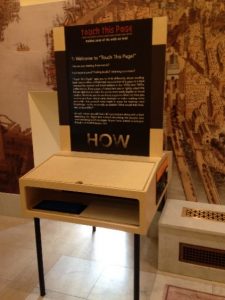by Rachael Allen
“Ask yourself: what might it mean for reading—and knowledge—to be universally accessible? What would that look, feel, or sound like?” This is what the exhibit Touch This Page! Making Sense of the Ways We Read asks its readers, who access the exhibit by touch, sound, or sight. Touch This Page!, an online exhibit on the multisensory experience of reading, endeavors to follow its own premise.
Created in partnership among Harvard Library, Northeastern University, and

Perkins School for the Blind, the digital exhibit consists of 6 narrative sections that focus on the early experimentation with raised text for visually impaired readers, correlating these early ideas to current discussions on universal design. The exhibit highlights in particular the Boston Line Type which was developed in the early 19th century by Samuel Gridley Howe, the first director of the Perkins School for the Blind. Unlike Braille, this text could be read both visually and by touch.
Visitors can read the narrative sections of the exhibit multiple ways—visually through digital text, auditorily through an audio recording, or tactilely by downloading a file to 3D-print raised text. Each section also includes 3D digital replicas of Boston Line Type and other designs, copied from examples in the collections at the Perkins Archives. Visitors can view these objects, which include a map of Massachusetts and a diagram of a moon eclipse, directly on the website or can hear them using a screen-reader. Alternatively, they can be downloaded as audio or 3D printing files.
While the digital exhibit is ongoing, there are also 4 pop-up exhibits located around Greater Boston between January and April 2019. Excited about an exhibit on multisensory reading, I decided to visit the in-person exhibit at the Norman B. Leventhal Map and Education Center, which is inside the Copley Square Branch of the Boston Public Library.

The pop-up exhibit, which I found easily right outside the Center’s entrance, consisted of 3 double-sided kiosks—6 exhibit sections in total. While I hadn’t explored the online exhibit before attending in person, the physical exhibit was essentially a direct translation of the online version. Each section included visual text, a Braille version of the text, and a sort of cupboard below containing a 3D-printed block with raised lettering and designs, as well as visual and Braille text explaining the objects.
I enjoyed feeling the 3D models and interacting with the exhibit overall, although I found that it took a lot of energy in the moment to read through the narrative. I ended up reading through only 2 or 3 of the sections, and thus didn’t view the complete story. However, the next day I was able to look through the full exhibit online at a relaxed pace in the comfort of my own home. In this way, the online and physical versions of the exhibit complement each other, multiplying the ways in which we can access and experience the exhibit.
In addition to the exhibit at the Boston Public Library, the 3 other pop-up exhibit locations include Harvard University’s Lamont Library, Northeastern University’s Snell Library, and Perkins School for the Blind. While the University exhibits require affiliate IDs for entrance and the Perkins exhibit access is by appointment only, each institution expands the audience for the exhibit to reach its own community. The physical exhibits also provide a chance for visitors who don’t have access to 3D printers to examine the raised type replicas.
Far from a one-off exhibit, Touch This Page! will still be available online even after the pop-up exhibits close. In addition, corresponding events include the companion exhibit Tactile Books: Making Sense of the Ways We Read which is open to the public at the Houghton Library until April 15, 2019, and A Symposium on Ability, Access, and the Archive at Northeastern University and Harvard University from April 4-5, 2019. For those wishing to contribute to an ongoing dialogue on the exhibit, there is a section on the website to submit responses to Touch This Page!
